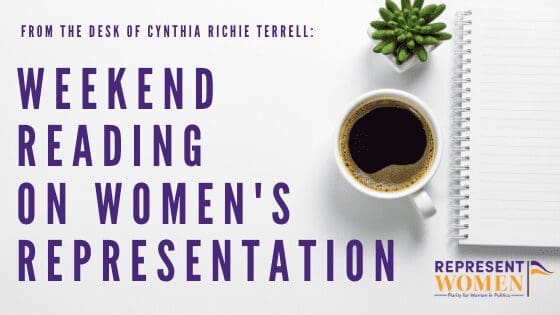
‘Unabashed Fascism’: Trump Executive Order Targets ‘Improper Ideology’ at Smithsonian | Common Dreams
March 28, 2025
DEFCON 3
March 28, 2025Weekend Reading on Women’s Representation is a compilation of stories about women’s representation in politics, on boards, in sports and entertainment, in judicial offices and in the private sector in the U.S. and around the world—with a little gardening and goodwill mixed in for refreshment!
The final week of Women’s History Month seems like a good time to remember several notable women whose contributions have paved the way for our generation’s work to advance women’s representation and leadership, including the birthdays of civil rights leaders Dr. Dorothy Height and Gloria Steinem….
… the first woman to serve on the U.S. Supreme Court Sandra Day O’Connor …
… the first woman to serve as speaker of the House Nancy Pelosi, RepresentWomen’s Arianna Conte, and members of Congress Catherine Cortez Masto and Jasmine Crockett, and the recent deaths of former Reps. Nita Lowey and Mia Love.
Rest in power, Rep. Nita Lowey—a New York Democrat who was the first woman to chair the powerful House Appropriations Committee.
Mia Love—a former Utah representative the first Black Republican woman to serve in Congress—died earlier this week. Rest in power, Rep. Love.
This year’s Women’s History Month theme is Moving Forward Together: Women Educating and Inspiring Generations.
This month, RepresentWomen hosted our fourth annual Democracy Solutions Summit and released a brief exploring gender parity and women’s representation in the United States, Mexico and Canada. Comparisons between and among nations are a rich source of information about the impact that systems strategies, like electoral reforms, can have on outcomes for women’s representation and leadership. Women must both have access to data-driven solutions that can increase women’s representation and participate in dedicated and intentional spaces to turn those solutions into action.
This week’s Weekend Reading covers potential women candidates for the presidency in 2028, women candidates for governor Maine and Alaska, the fight for voting rights across the nation, tariffs and the pink tax.
Women Can Win the Presidential Election in 2028
The New York Times profiles Alexandria Ocasio-Cortez as a leading contender to inherit the progressive mantle Vermont U.S. Sen. Bernie Sanders passed in the last decade. First elected as a 28-year-old bartender in one of the biggest upsets in political history, Ocasio-Cortez has earned respect from her congressional colleagues while maintaining support in her progressive base. Here is an excerpt from the article:
“Though there is little agreement about who will emerge to guide progressives into a post-Sanders era, virtually everyone interviewed said there was one clear leader for the job: Representative Alexandria Ocasio-Cortez of New York…
Danielle Brecker, a leader of Empire State Indivisible, which has called on Mr. Schumer to step aside as minority leader, said she saw Ms. Ocasio-Cortez as the “future of the party” with any number of promising paths. But she questioned the country’s willingness to elect a woman in 2028. “I sadly think that it probably needs to be some very safe white man,” she said. “I feel terrible saying that. That wound is still very sore.”
Women’s representation advocates must push back hard against this narrative. Hillary Clinton and Kamala Harris did not lose to Donald Trump because they were women. In 2016 and 2024, more voters in the key swing states wanted to vote for change than for the continuity that Clinton and Harris represented. Even with that challenge, Clinton won the popular vote by nearly 3 million votes in 2016, while Harris in 2024 outperformed projections for Joe Biden and was seen in a post-election poll by YouGov as Democrats’ strongest candidate.
On the Democratic side, women clearly can win in swing districts. Democratic women won U.S. Senate races in 2024 in states carried by Donald Trump in Nevada (Jacky Rosen), Michigan (Elissa Slotkin), and Wisconsin (Tammy Baldwin), and hold governor’s seats in the swing states of Arizona (Katie Hobbs) and Michigan (Gretchen Whitmer).
Of the Democrats’ three members in Republican House districts, two are women: Marcy Kaptur in Ohio and Marie Gluesenkamp Perez in Washington.
On the Republican side, it’s not yet clear what the party will seek in 2028, but several women are in the mix, such as current and former governors Sarah Huckabee Sanders, Nikki Haley or Kristi Noem. Whether it’s one of these women or other proven vote-getters, history need not wait.
Will Alaska and Maine Elect a Woman Governor in 2026?
RepresentWomen has convened women leaders in person and virtually, like our annual Democracy Solutions Summit. Two speakers we’ve had the good fortune to work with are former Alaska Rep. Mary Peltola and Maine Secretary of State Shenna Bellows. Both are strong and effective advocates of ranked-choice voting, have won key RCV contests, and may soon be in the running to become governors of their state.
On March 26, Bellows announced her campaign for governor. Outgoing Gov. Janet Mills was Maine’s first woman governor and, not coincidentally, the first governor of Maine elected with RCV, coming out on top in a seven-candidate primary in 2018. Bellows became secretary of state in 2020, winning the support of her Democratic state legislative colleagues in a highly competitive RCV contest. She has since helped implement and defend RCV, including just last month testifying before the legislature in favor of RCV as it rejected a bill to repeal it. Here is an excerpt from her testimony:
Since its implementation, we have found voters appreciate the option to rank the candidates on their ballots, and that they have found it easy to vote in this manner. As it is exactly how we rank choices on all sorts of things every day – what to make for dinner for our families each night, what music to put on the radio, where to go on vacation – implementing ranked choice for voting was not difficult.
We also feel that voters appreciate the option to vote their heart, rather than having to stress and worry that voting for their favorite candidate in a plurality election may end up helping their least favorite candidate win, that they will have to vote for the lesser of two evils, or that their decision will split the vote. Voter frustration, often found in that plurality voting, does not always accurately reflect the will of the majority; and this is one of the reasons Maine voters chose RCV. Voters should feel and know that their vote matters, and that the elections they participate in result in representation that mirrors the electorate.”
Across the nation, Alaska has been led by men as governors for all but three years since becoming a state. It’s looking increasingly likely that a woman may be elected in 2026—when Alaska will, for the first time, have an open seat race for governor with its trailblazing electoral system that combines a unified primary and a general election where the use of ranked-choice voting enables voter choice and majority rule. That system has contributed to both legislative chambers being run by coalitions of Republicans, Democrats and Independents working across party lines.
On the Republican side, Lt. Gov. Nancy Dahlstrom is considered a likely candidate. Democrats are looking to former Rep. Peltola, who emerged to win a special election for Congress with the new system in 2022 and became a thoughtful proponent of RCV. A recent Data for Progress poll showed Peltola would have a 10-point lead over Dahlstrom and remains Alaska’s most popular politician, with a net positive rating of 5 percentage points and 50 percent favorability. The Hill reviewed the Alaska governor race in a deep dive – here’s an excerpt:
“Democrats are hopeful [Peltola] could pull off another win in 2026, in a state where a registered Democrat hasn’t held the governor’s mansion since 2002. “I can’t think of a Democrat who is better positioned than her, and I think she would stand a very strong chance,” said Alaska strategist John-Henry Heckendorn….
Despite the odds being against her, Peltola still nearly pulled off a win. She was just 2 points behind Begich in the first round of voting and ultimately lost by only 2.5 points in the final round. That was a significant overperformance compared to how former Vice President Harris (D) fared, losing the state by 13 points. “Peltola is putting up one of the top five performances in the [election] for a Democrat anywhere in the country. By that metric, she’s probably one of the most talented Democratic candidates in the U.S.” Heckendorn said.”
Will Lawmakers in Colorado, Illinois, Maryland and New Jersey Stand up for Voting Rights?
Incumbent protection and status quo bias are barriers for women seeking to break into the traditional “old boys’ networks” of elected representation. Women have had their greatest relative success in local government, and Stateline takes a deep dive into a state-based pro-democracy strategy to protect voting rights and create new opportunities for voters based on state Voting Rights Acts. The timeliness of this legislation was only deepened by the disturbing executive order on voting from the Trump administration on March 25 that represented an attempt to hijack the bipartisan Election Assistance Commission and use it as a cudgel to enact long-time partisan priorities that risk access to the ballot for millions of eligible voters.
RepresentWomen backs this legislation in my home state of Maryland, and take a look at whether there’s a legislative effort in your state. Here’s an excerpt from Stateline:
Seeing federal courts slash away at the Voting Rights Act, some states are seeking to resurrect fallen protections for non-white voters with their own versions of the landmark law passed during the height of the Civil Rights Movement. Democratic lawmakers in Alabama, Arizona, Colorado, Florida, Illinois, Maryland and New Jersey are pushing such legislation this session, attempting to join seven other states with similar laws enacted in recent years….
“You can’t rely on the federal government to do the right thing,” said Democratic state Sen. Charles Sydnor III, who is sponsoring the Maryland Voting Rights Act. Maryland’s measure, passed the state Senate this month and will have a House committee hearing next week, seeks to ensure that racial minority communities are fairly represented in county and municipal districts. …
However, even for states that are seen by democracy advocates as having the strongest pro-voter policies, it’s important to pass these measures, said Colorado state Sen. Julie Gonzales, a Democrat who is sponsoring a broad Voting Rights Act in her state. Colorado has the “gold standard” of elections, but more can be done to close the racial disparities of voter participation, she said, noting her Chicana background.
Women Earn Support in Oakland Special Election on April 15
The City of Oakland will hold special elections with ranked-choice voting for mayor and a city council seat on April 15th. Former Rep. Barbara Lee has earned the support of five former mayors, among others, and this week picked up the endorsement of the San Jose Mercury News, as did Charlene Wang in the special election for District 2 on the city council. From the editorial:
Of the 10 mayoral candidates in the April 15 special election, only former Rep. Barbara Lee has the political clout needed to unify the city’s fractured leadership. In District 2, Charlene Wang stands out among six candidates for her strong community support combined with a realistic approach to the city’s financial challenges and an emphasis on public safety.
It’s time for responsible leaders in City Hall who will address the city’s fiscal crisis and serious shortage of police. Oakland needs leaders willing to make tough decisions rather than dig a deeper financial hole….In the six-person [District 2] field, there are three candidates with solid handles on the gravity of the situation: Charlene Wang, Harold Lowe and Kanitha Matoury. In the city’s ranked-choice voting, we recommend them for the first, second and third votes, respectively.”
Impact of the Pink Tax on Women in 2025
Over the last few days, President Trump has imposed a 25 percent tariff on goods imported from Canada and Mexico, an increased 10 percent tariff on goods imported from China, a 25 percent tariff on auto imports, and threatened to impose larger tariffs on goods imported from the E.U. and Canada.
While these changes will impact Americans’ wallets across the board, women will disproportionately feel the effects. Two Democratic representatives, Lizzie Fletcher (Texas) and Brittany Pettersen (Colorado), have reintroduced legislation (the Pink Tariffs Study Act) requiring the Treasury to study tariff rates for gender bias. Dating as far back as the 1930s, women’s goods have been taxed at a higher rate than men’s. In addition to introducing legislation, removing gender from the statistical calculations for tariff rates is another way to reduce costs for women.
Katherine Long writes in POLITICO:
But multiple studies on tariff rates and their impact have shown that tariffs don’t always fall equally on all consumers. A 2018 study by the U.S. International Trade Commission found that lower income consumers pay a larger share of their wages in tariffs. What’s more, the report found, women shoulder more of the tariff burden, paying more than men for gendered products such as clothing and shoes.
“It is very strange and hugely inappropriate that the U.S. government should be having differential tax rates that attack women more than men for essentially the same things,” Ed Gresser, vice president and director for trade and global markets at the Progressive Policy Institute, tells Women Rule.
Gresser also researched the gender imbalance in tariff rates. He found that in 2022, average tariff rates for women’s clothing were higher than men’s, at 16.7 percent compared to 13.6 percent. This equates to a $2.7 billion gender gap.
Black Women Leading the Charge to Protect Voting Rights and Democracy
An article written by Alphonso David and Kimiya Factory in Essence highlights 14 Black women leading the charge for expanding and protecting voting rights in America. From election judges like Tracy Groomes ensuring smooth polling processes to legal advocates like Jennifer Nwachukwu fighting for voter protection, each woman plays a crucial role. Various perspectives and approaches are needed to ensure a healthy democracy. Visit the Essence website for the complete list.
In a time when democracy and its core tenants, including voting rights, are under direct threat, it’s more important than ever to recognize the Black women on the frontlines, fighting every day to protect our fundamental freedoms. Last year, the Global Black Economic Forum and the Lawyers’ Committee for Civil Rights Under Law launched Ojo Asé: Black Women Answering the Call, a national voting rights campaign dedicated to ensuring that Black women leading this charge at a grassroots, local level receive the recognition they deserve. Meet 15 Freedom Fighters nominated by their communities, whose remarkable contributions and tireless efforts are fighting for the future of our democracy.
Lessons for Targeting from Florida’s Special Elections
No one has ever served in the U.S. House without an election. Since November, four seats have become vacant.
The first two up for election are in Florida to fill vacancies created in 1st Congressional District (CD-1) by the resignation of Matt Gaetz and in CD-6 by the appointment of Michael Waltz to be national security advisor.
Both seats lean heavily Republican, making them of limited value for measuring the political impact of the Trump administration. Using the Cook Partisan Voting Index (PVI, a measurement most recently based on the 2016 and 2020 presidential election results in districts that was first developed by my husband Rob Richie), CD1 is +19 Republican, meaning on average, a Republican should get 69 percent of the vote, making it among the 50 most Republican districts in the country, while CD6 is +14 Republican, meaning on average a Republican should win with 64 percent.
In CD1, Democrats have nominated their 2024 nominee, Gay Valimont, while the other Democratic nominee in CD 6 and both Republican nominees are men. Democrats have heavily outraised their opponent, including Vamont bringing in $6.4 million by March 12, but narrowing margins may best measure success. The power of PVI over the quality of candidates and money raised is clear. Republicans hold only two seats in congressional districts that are at least +1 Democratic (CA’s CD-22 that is +5 Democratic, and NY’s CD-3 that is +3 Democratic), while Democrats hold only three seats (OH’s CD-9 that is +3 Republican), WA’s CD-3 that is +5 Republican and ME’s CD-2 that is +6 Republican) in districts with a PVI that is more than +1 Republican.
In other words, Republicans hold 212 of the 215 most Republican districts, and Democrats hold 206 of the 208 most Democratic districts.
For activists and donors focused on electing more women, this stark reality shows there are two paths toward progress: changing our winner-take-all, single-member district system to open up the country to real competition in November and focusing with intensity on chances to win primaries in districts leaning toward that party.
The SAVE Act Threatens Voter Access and Undermines Registration Efforts
The SAVE Act presents barriers for people to participate in democracy fully. It would require all voters to provide documentary proof of citizenship (such as a passport or birth certificate with a photo ID) for federal elections, eliminating online and third-party voter registration and drastically restricting voter access. Among the many groups of people who would be impacted are the 69 million women who do not have their legal name on their birth certificates.
Other concerns include:
- The SAVE Act would put an end to third-party voter registration drives, as only government officials would be authorized to verify citizenship documents.
- It would eliminate online voter registration, requiring millions of people to register in person instead.
- This change would significantly burden election offices, resulting in long lines, increased costs, and logistical challenges.
- The bill would disenfranchise tens of millions of eligible voters, particularly those from low-income communities, rural areas, and women, as well as individuals who do not have easy access to the required documents.
Brian Miller writes in a blog post for Nonprofit Vote:
We are calling on Congress to reject the Safeguard American Voter Eligibility (SAVE) Act, H.R. 22, which could go directly to a House floor vote this month as it is one of 12 bills identified for fast tracking. A companion bill, S.128, has also been filed in the Senate where it would likely need to overcome the filibuster. This bill, on its surface, requires proof of citizenship for registering to vote in any and all federal elections. However, the implementation of the law would have dramatic effects on our work and the communities we serve.
While it is reasonable to prevent non-citizens from voting, existing law already does that. All federal voter registration forms include a checkbox requiring registrants to positively affirm citizenship. Violating that is punishable and instances of non-citizens voting is exceedingly rare.
Happy birthday to RepresentWomen’s resident artist, Melanie Humble!
That’s all for this week, enjoy your weekend!
Great Job Cynthia Richie Terrell & the Team @ Ms. Magazine Source link for sharing this story.







